BBUS1003 Business Communication: Language, Culture & Workplace
VerifiedAdded on 2023/03/23
|7
|1517
|31
Essay
AI Summary
This essay examines the critical relationship between language and culture in the context of business communication, emphasizing how these elements influence interactions within global organizations. It identifies and discusses various barriers to intercultural communication, including cultural differences in ethics, values, and behaviors, as well as language barriers that can lead to misunderstandings. Furthermore, the essay analyzes the impact of cultural diversity in the workplace, highlighting both the advantages and challenges it presents. It suggests strategies for managing cultural differences, such as promoting teamwork and creating an inclusive work environment. The paper concludes by underscoring the importance of understanding and addressing these factors to foster effective communication and collaboration in multicultural business settings. Desklib offers a wealth of similar resources, including past papers and solved assignments, to aid students in their studies.
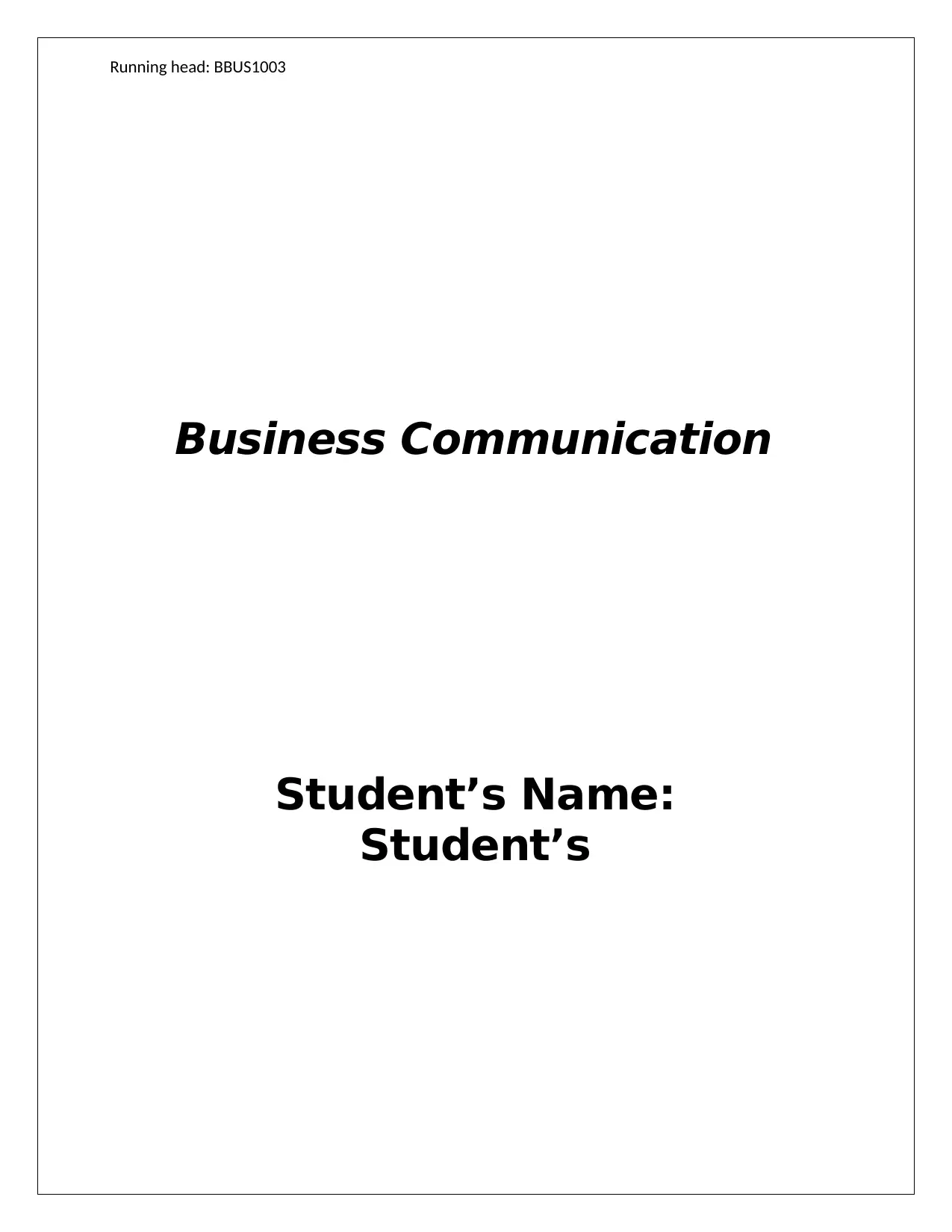
Running head: BBUS1003
Business Communication
Student’s Name:
Student’s
Business Communication
Student’s Name:
Student’s
Paraphrase This Document
Need a fresh take? Get an instant paraphrase of this document with our AI Paraphraser
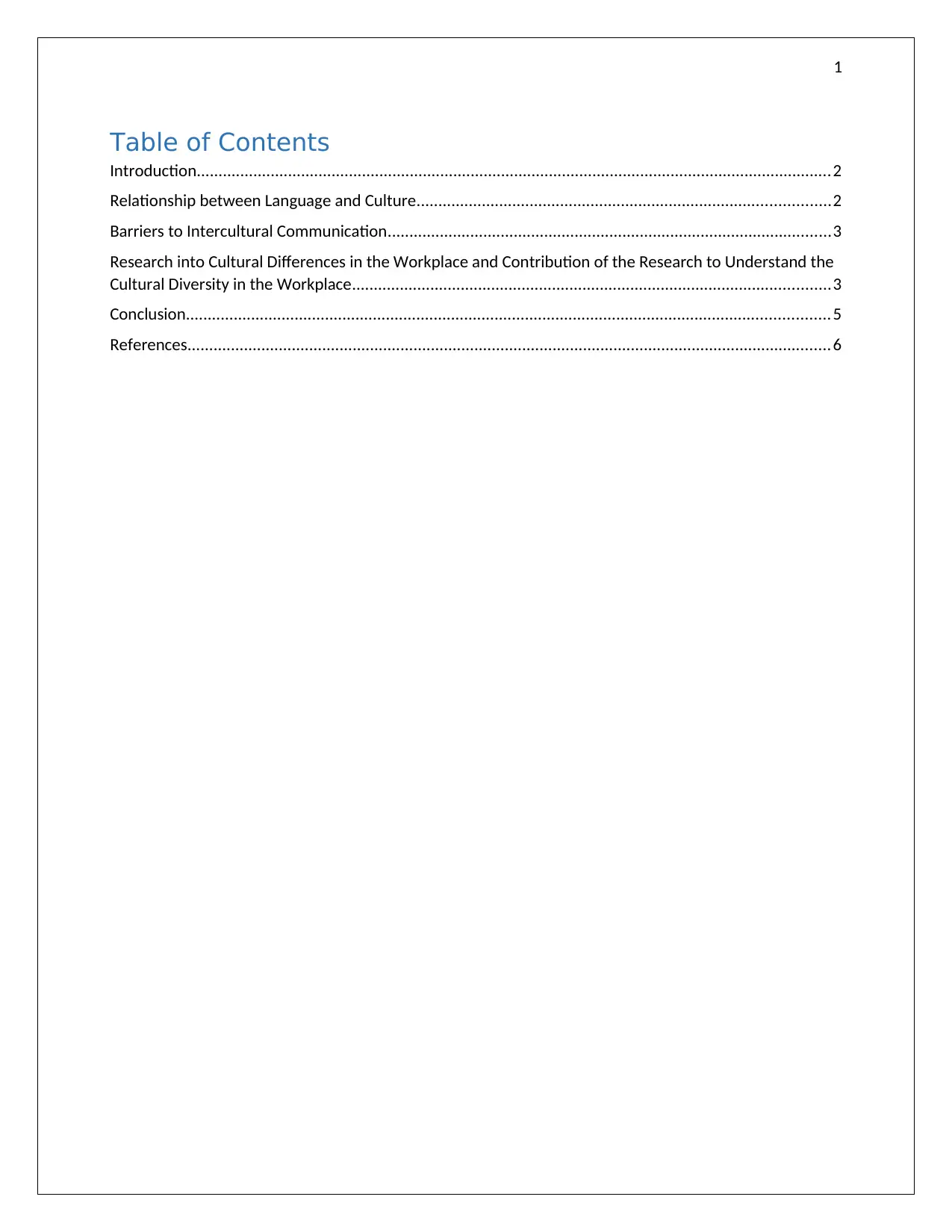
1
Table of Contents
Introduction..................................................................................................................................................2
Relationship between Language and Culture...............................................................................................2
Barriers to Intercultural Communication......................................................................................................3
Research into Cultural Differences in the Workplace and Contribution of the Research to Understand the
Cultural Diversity in the Workplace..............................................................................................................3
Conclusion....................................................................................................................................................5
References....................................................................................................................................................6
Table of Contents
Introduction..................................................................................................................................................2
Relationship between Language and Culture...............................................................................................2
Barriers to Intercultural Communication......................................................................................................3
Research into Cultural Differences in the Workplace and Contribution of the Research to Understand the
Cultural Diversity in the Workplace..............................................................................................................3
Conclusion....................................................................................................................................................5
References....................................................................................................................................................6
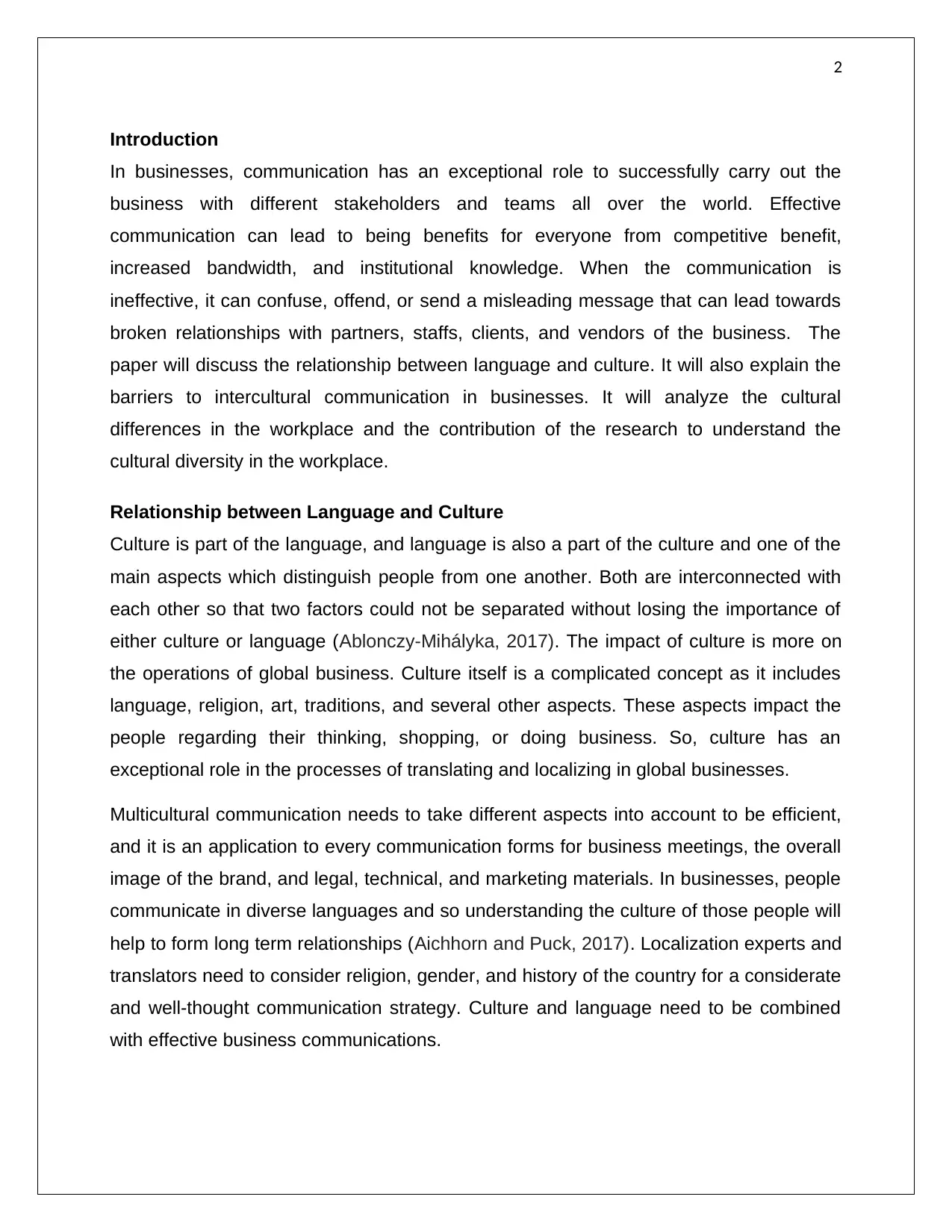
2
Introduction
In businesses, communication has an exceptional role to successfully carry out the
business with different stakeholders and teams all over the world. Effective
communication can lead to being benefits for everyone from competitive benefit,
increased bandwidth, and institutional knowledge. When the communication is
ineffective, it can confuse, offend, or send a misleading message that can lead towards
broken relationships with partners, staffs, clients, and vendors of the business. The
paper will discuss the relationship between language and culture. It will also explain the
barriers to intercultural communication in businesses. It will analyze the cultural
differences in the workplace and the contribution of the research to understand the
cultural diversity in the workplace.
Relationship between Language and Culture
Culture is part of the language, and language is also a part of the culture and one of the
main aspects which distinguish people from one another. Both are interconnected with
each other so that two factors could not be separated without losing the importance of
either culture or language (Ablonczy-Mihályka, 2017). The impact of culture is more on
the operations of global business. Culture itself is a complicated concept as it includes
language, religion, art, traditions, and several other aspects. These aspects impact the
people regarding their thinking, shopping, or doing business. So, culture has an
exceptional role in the processes of translating and localizing in global businesses.
Multicultural communication needs to take different aspects into account to be efficient,
and it is an application to every communication forms for business meetings, the overall
image of the brand, and legal, technical, and marketing materials. In businesses, people
communicate in diverse languages and so understanding the culture of those people will
help to form long term relationships (Aichhorn and Puck, 2017). Localization experts and
translators need to consider religion, gender, and history of the country for a considerate
and well-thought communication strategy. Culture and language need to be combined
with effective business communications.
Introduction
In businesses, communication has an exceptional role to successfully carry out the
business with different stakeholders and teams all over the world. Effective
communication can lead to being benefits for everyone from competitive benefit,
increased bandwidth, and institutional knowledge. When the communication is
ineffective, it can confuse, offend, or send a misleading message that can lead towards
broken relationships with partners, staffs, clients, and vendors of the business. The
paper will discuss the relationship between language and culture. It will also explain the
barriers to intercultural communication in businesses. It will analyze the cultural
differences in the workplace and the contribution of the research to understand the
cultural diversity in the workplace.
Relationship between Language and Culture
Culture is part of the language, and language is also a part of the culture and one of the
main aspects which distinguish people from one another. Both are interconnected with
each other so that two factors could not be separated without losing the importance of
either culture or language (Ablonczy-Mihályka, 2017). The impact of culture is more on
the operations of global business. Culture itself is a complicated concept as it includes
language, religion, art, traditions, and several other aspects. These aspects impact the
people regarding their thinking, shopping, or doing business. So, culture has an
exceptional role in the processes of translating and localizing in global businesses.
Multicultural communication needs to take different aspects into account to be efficient,
and it is an application to every communication forms for business meetings, the overall
image of the brand, and legal, technical, and marketing materials. In businesses, people
communicate in diverse languages and so understanding the culture of those people will
help to form long term relationships (Aichhorn and Puck, 2017). Localization experts and
translators need to consider religion, gender, and history of the country for a considerate
and well-thought communication strategy. Culture and language need to be combined
with effective business communications.
⊘ This is a preview!⊘
Do you want full access?
Subscribe today to unlock all pages.

Trusted by 1+ million students worldwide
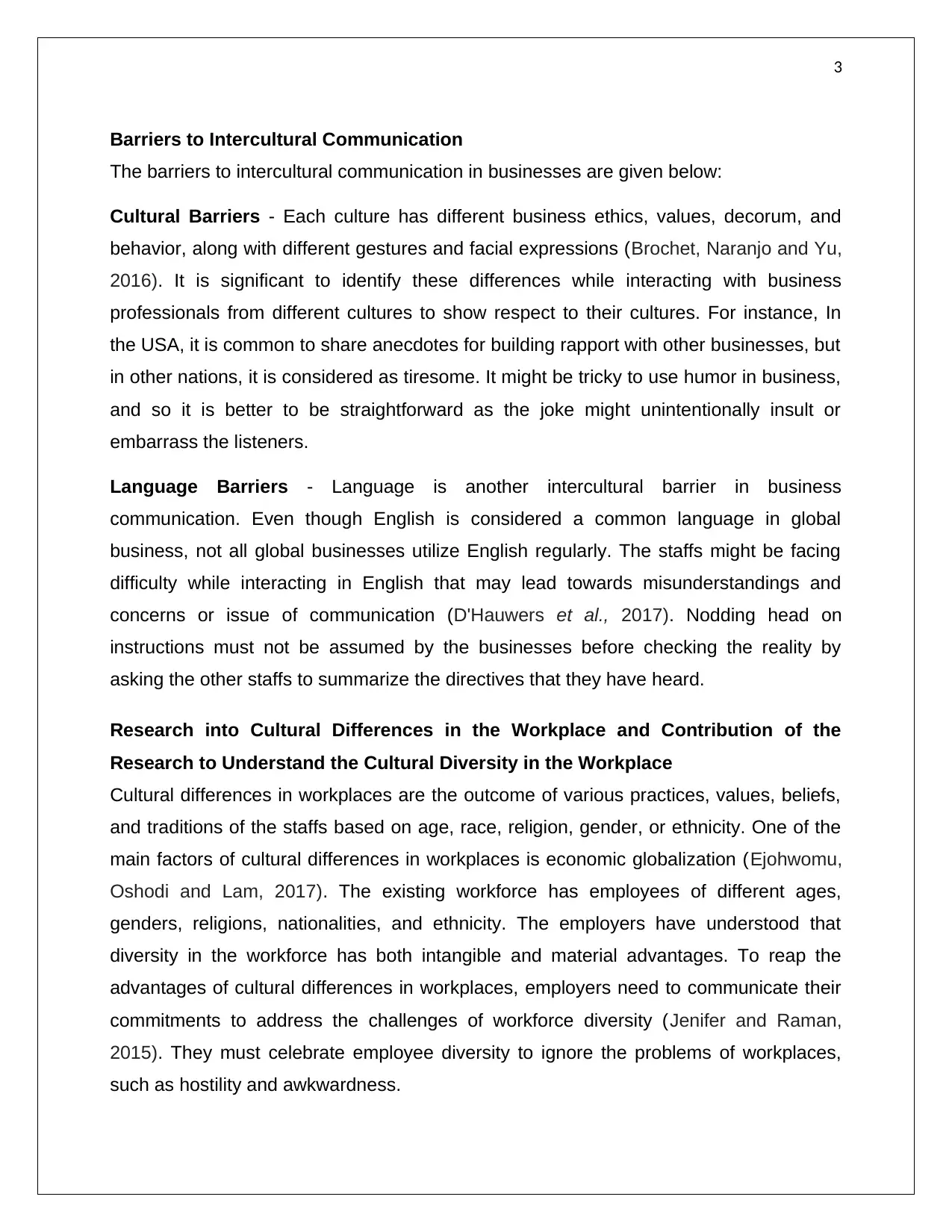
3
Barriers to Intercultural Communication
The barriers to intercultural communication in businesses are given below:
Cultural Barriers - Each culture has different business ethics, values, decorum, and
behavior, along with different gestures and facial expressions (Brochet, Naranjo and Yu,
2016). It is significant to identify these differences while interacting with business
professionals from different cultures to show respect to their cultures. For instance, In
the USA, it is common to share anecdotes for building rapport with other businesses, but
in other nations, it is considered as tiresome. It might be tricky to use humor in business,
and so it is better to be straightforward as the joke might unintentionally insult or
embarrass the listeners.
Language Barriers - Language is another intercultural barrier in business
communication. Even though English is considered a common language in global
business, not all global businesses utilize English regularly. The staffs might be facing
difficulty while interacting in English that may lead towards misunderstandings and
concerns or issue of communication (D'Hauwers et al., 2017). Nodding head on
instructions must not be assumed by the businesses before checking the reality by
asking the other staffs to summarize the directives that they have heard.
Research into Cultural Differences in the Workplace and Contribution of the
Research to Understand the Cultural Diversity in the Workplace
Cultural differences in workplaces are the outcome of various practices, values, beliefs,
and traditions of the staffs based on age, race, religion, gender, or ethnicity. One of the
main factors of cultural differences in workplaces is economic globalization (Ejohwomu,
Oshodi and Lam, 2017). The existing workforce has employees of different ages,
genders, religions, nationalities, and ethnicity. The employers have understood that
diversity in the workforce has both intangible and material advantages. To reap the
advantages of cultural differences in workplaces, employers need to communicate their
commitments to address the challenges of workforce diversity (Jenifer and Raman,
2015). They must celebrate employee diversity to ignore the problems of workplaces,
such as hostility and awkwardness.
Barriers to Intercultural Communication
The barriers to intercultural communication in businesses are given below:
Cultural Barriers - Each culture has different business ethics, values, decorum, and
behavior, along with different gestures and facial expressions (Brochet, Naranjo and Yu,
2016). It is significant to identify these differences while interacting with business
professionals from different cultures to show respect to their cultures. For instance, In
the USA, it is common to share anecdotes for building rapport with other businesses, but
in other nations, it is considered as tiresome. It might be tricky to use humor in business,
and so it is better to be straightforward as the joke might unintentionally insult or
embarrass the listeners.
Language Barriers - Language is another intercultural barrier in business
communication. Even though English is considered a common language in global
business, not all global businesses utilize English regularly. The staffs might be facing
difficulty while interacting in English that may lead towards misunderstandings and
concerns or issue of communication (D'Hauwers et al., 2017). Nodding head on
instructions must not be assumed by the businesses before checking the reality by
asking the other staffs to summarize the directives that they have heard.
Research into Cultural Differences in the Workplace and Contribution of the
Research to Understand the Cultural Diversity in the Workplace
Cultural differences in workplaces are the outcome of various practices, values, beliefs,
and traditions of the staffs based on age, race, religion, gender, or ethnicity. One of the
main factors of cultural differences in workplaces is economic globalization (Ejohwomu,
Oshodi and Lam, 2017). The existing workforce has employees of different ages,
genders, religions, nationalities, and ethnicity. The employers have understood that
diversity in the workforce has both intangible and material advantages. To reap the
advantages of cultural differences in workplaces, employers need to communicate their
commitments to address the challenges of workforce diversity (Jenifer and Raman,
2015). They must celebrate employee diversity to ignore the problems of workplaces,
such as hostility and awkwardness.
Paraphrase This Document
Need a fresh take? Get an instant paraphrase of this document with our AI Paraphraser

4
Identifying and celebrating cultural diversity is significant for a healthy work atmosphere.
The businesses who fail to embrace the cultural differences falls behind the competition.
The employers, leaders, and managers those who have the capability to manage the
members of their team from diverse backgrounds sensibly could be more successful in
the culturally diverse working atmosphere.
Managing Cultural Differences
The issues of cultural differences could be handled if the managers take adequate
measures to ensure that their organizations are recognized for acceptance and
tolerance. Some of the measures to manage the issues of cultural differences in
workplaces are as follows:
Motivating for Teamwork - It is significant to motivate the staffs to be open-minded and
concentrate on teamwork and not on individual diversity. The managers can perceive
the changes in team dynamics as cultural diversity will come to light, and communication
becomes more difficult (Mittal, 2018). But the common objectives and targets of the
projects of the team must have strong foundations on which the cultural understanding
can be built. They also have to be conscious of the perception of various cultures on
teamwork.
Changing Work Environment - The role of the managers is to build a work
atmosphere where cultural diversity is respected, staffs understand their colleagues and
the teams have the opportunities to achieve their targets and become successful
(Pedersen and Netter, 2015). Building such type of work environment implies that
cultural differences must be identified, respected, and celebrated. Open communication
regarding cultural diversity, breaking the misconceptions with relevant information and
knowledge, and addressing the far-standing concepts could help to build fair work
atmosphere where all the employees will feel free and safe.
Identifying and celebrating cultural diversity is significant for a healthy work atmosphere.
The businesses who fail to embrace the cultural differences falls behind the competition.
The employers, leaders, and managers those who have the capability to manage the
members of their team from diverse backgrounds sensibly could be more successful in
the culturally diverse working atmosphere.
Managing Cultural Differences
The issues of cultural differences could be handled if the managers take adequate
measures to ensure that their organizations are recognized for acceptance and
tolerance. Some of the measures to manage the issues of cultural differences in
workplaces are as follows:
Motivating for Teamwork - It is significant to motivate the staffs to be open-minded and
concentrate on teamwork and not on individual diversity. The managers can perceive
the changes in team dynamics as cultural diversity will come to light, and communication
becomes more difficult (Mittal, 2018). But the common objectives and targets of the
projects of the team must have strong foundations on which the cultural understanding
can be built. They also have to be conscious of the perception of various cultures on
teamwork.
Changing Work Environment - The role of the managers is to build a work
atmosphere where cultural diversity is respected, staffs understand their colleagues and
the teams have the opportunities to achieve their targets and become successful
(Pedersen and Netter, 2015). Building such type of work environment implies that
cultural differences must be identified, respected, and celebrated. Open communication
regarding cultural diversity, breaking the misconceptions with relevant information and
knowledge, and addressing the far-standing concepts could help to build fair work
atmosphere where all the employees will feel free and safe.
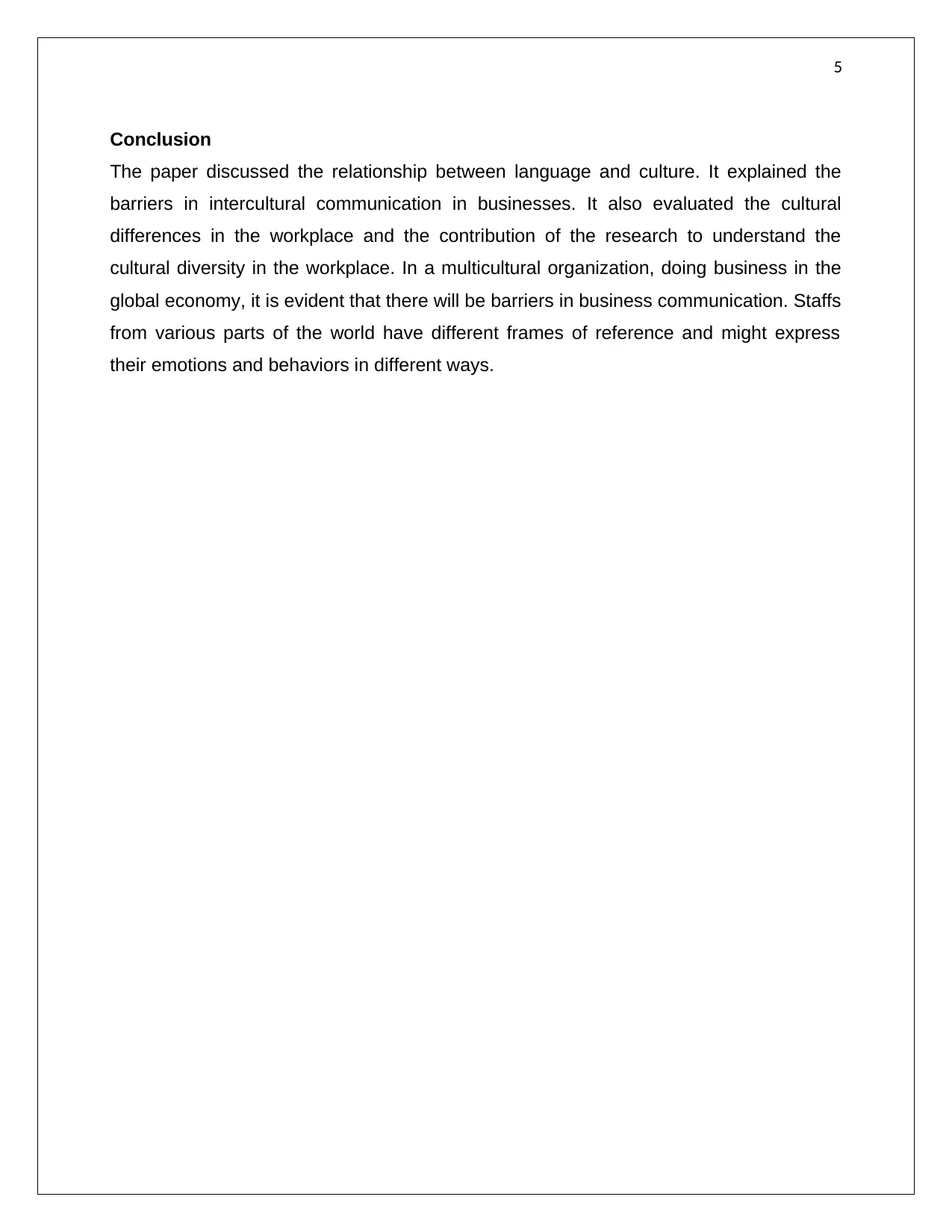
5
Conclusion
The paper discussed the relationship between language and culture. It explained the
barriers in intercultural communication in businesses. It also evaluated the cultural
differences in the workplace and the contribution of the research to understand the
cultural diversity in the workplace. In a multicultural organization, doing business in the
global economy, it is evident that there will be barriers in business communication. Staffs
from various parts of the world have different frames of reference and might express
their emotions and behaviors in different ways.
Conclusion
The paper discussed the relationship between language and culture. It explained the
barriers in intercultural communication in businesses. It also evaluated the cultural
differences in the workplace and the contribution of the research to understand the
cultural diversity in the workplace. In a multicultural organization, doing business in the
global economy, it is evident that there will be barriers in business communication. Staffs
from various parts of the world have different frames of reference and might express
their emotions and behaviors in different ways.
⊘ This is a preview!⊘
Do you want full access?
Subscribe today to unlock all pages.

Trusted by 1+ million students worldwide
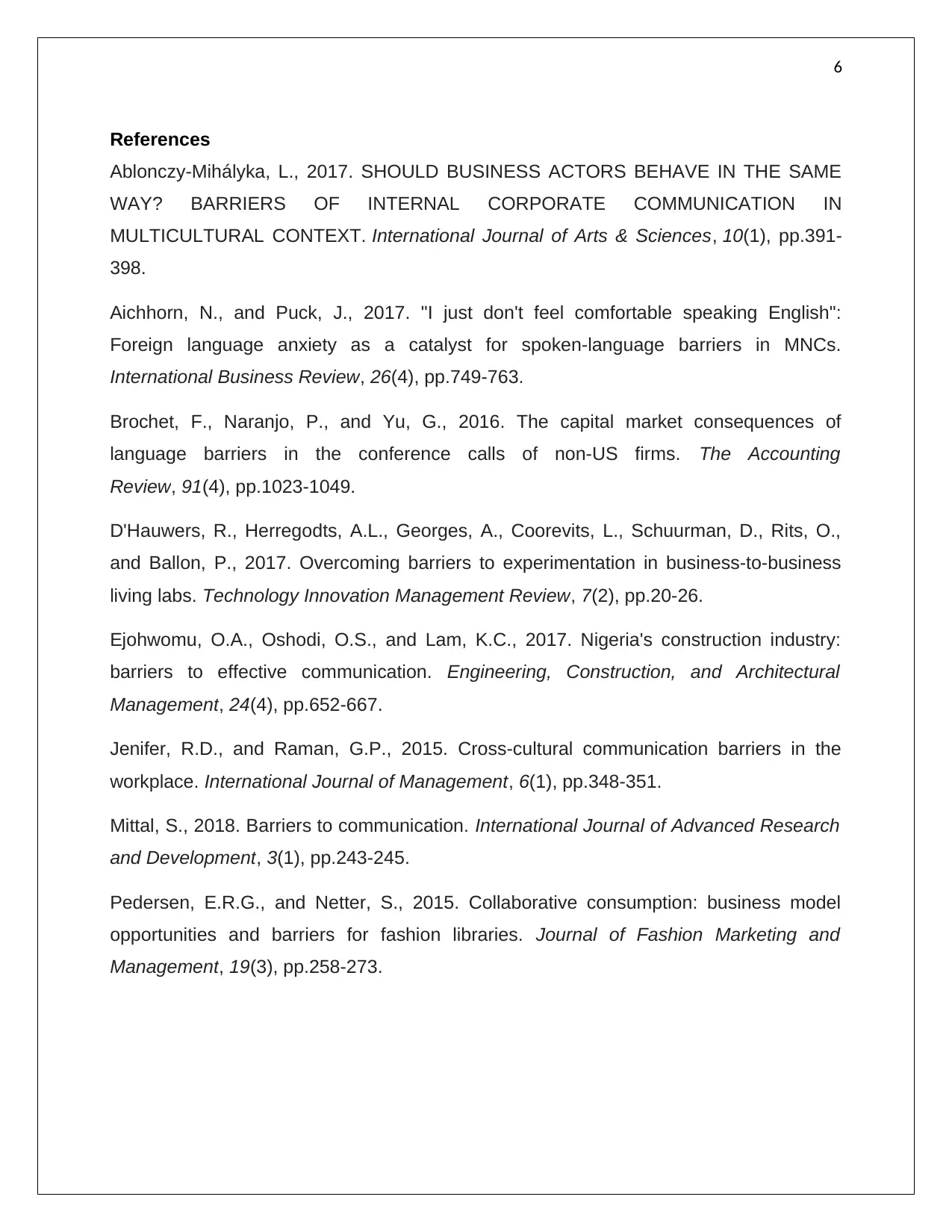
6
References
Ablonczy-Mihályka, L., 2017. SHOULD BUSINESS ACTORS BEHAVE IN THE SAME
WAY? BARRIERS OF INTERNAL CORPORATE COMMUNICATION IN
MULTICULTURAL CONTEXT. International Journal of Arts & Sciences, 10(1), pp.391-
398.
Aichhorn, N., and Puck, J., 2017. "I just don't feel comfortable speaking English":
Foreign language anxiety as a catalyst for spoken-language barriers in MNCs.
International Business Review, 26(4), pp.749-763.
Brochet, F., Naranjo, P., and Yu, G., 2016. The capital market consequences of
language barriers in the conference calls of non-US firms. The Accounting
Review, 91(4), pp.1023-1049.
D'Hauwers, R., Herregodts, A.L., Georges, A., Coorevits, L., Schuurman, D., Rits, O.,
and Ballon, P., 2017. Overcoming barriers to experimentation in business-to-business
living labs. Technology Innovation Management Review, 7(2), pp.20-26.
Ejohwomu, O.A., Oshodi, O.S., and Lam, K.C., 2017. Nigeria's construction industry:
barriers to effective communication. Engineering, Construction, and Architectural
Management, 24(4), pp.652-667.
Jenifer, R.D., and Raman, G.P., 2015. Cross-cultural communication barriers in the
workplace. International Journal of Management, 6(1), pp.348-351.
Mittal, S., 2018. Barriers to communication. International Journal of Advanced Research
and Development, 3(1), pp.243-245.
Pedersen, E.R.G., and Netter, S., 2015. Collaborative consumption: business model
opportunities and barriers for fashion libraries. Journal of Fashion Marketing and
Management, 19(3), pp.258-273.
References
Ablonczy-Mihályka, L., 2017. SHOULD BUSINESS ACTORS BEHAVE IN THE SAME
WAY? BARRIERS OF INTERNAL CORPORATE COMMUNICATION IN
MULTICULTURAL CONTEXT. International Journal of Arts & Sciences, 10(1), pp.391-
398.
Aichhorn, N., and Puck, J., 2017. "I just don't feel comfortable speaking English":
Foreign language anxiety as a catalyst for spoken-language barriers in MNCs.
International Business Review, 26(4), pp.749-763.
Brochet, F., Naranjo, P., and Yu, G., 2016. The capital market consequences of
language barriers in the conference calls of non-US firms. The Accounting
Review, 91(4), pp.1023-1049.
D'Hauwers, R., Herregodts, A.L., Georges, A., Coorevits, L., Schuurman, D., Rits, O.,
and Ballon, P., 2017. Overcoming barriers to experimentation in business-to-business
living labs. Technology Innovation Management Review, 7(2), pp.20-26.
Ejohwomu, O.A., Oshodi, O.S., and Lam, K.C., 2017. Nigeria's construction industry:
barriers to effective communication. Engineering, Construction, and Architectural
Management, 24(4), pp.652-667.
Jenifer, R.D., and Raman, G.P., 2015. Cross-cultural communication barriers in the
workplace. International Journal of Management, 6(1), pp.348-351.
Mittal, S., 2018. Barriers to communication. International Journal of Advanced Research
and Development, 3(1), pp.243-245.
Pedersen, E.R.G., and Netter, S., 2015. Collaborative consumption: business model
opportunities and barriers for fashion libraries. Journal of Fashion Marketing and
Management, 19(3), pp.258-273.
1 out of 7
Related Documents
Your All-in-One AI-Powered Toolkit for Academic Success.
+13062052269
info@desklib.com
Available 24*7 on WhatsApp / Email
![[object Object]](/_next/static/media/star-bottom.7253800d.svg)
Unlock your academic potential
Copyright © 2020–2025 A2Z Services. All Rights Reserved. Developed and managed by ZUCOL.




